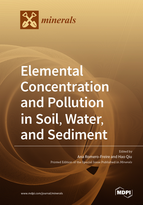Elemental Concentration and Pollution in Soil, Water, and Sediment
A special issue of Minerals (ISSN 2075-163X). This special issue belongs to the section "Environmental Mineralogy and Biogeochemistry".
Deadline for manuscript submissions: closed (18 June 2021) | Viewed by 64741
Special Issue Editors
Interests: ecotoxicology; remediation; bioassays; soil; metal pollution
Special Issues, Collections and Topics in MDPI journals
Interests: sustainable remediation; green technology; trace element; toxicity; model
Special Issues, Collections and Topics in MDPI journals
Special Issue Information
Dear Colleagues,
Certain elements are essential to the growth and health of living organisms with specific biochemical functions or processes in their metabolisms. However, when the amount of a trace element exceeds a certain threshold, it can become toxic, as “the dose makes the poison” (Paracelsus, 1567). Therefore, the environmental levels of various trace elements in soil, water, or sediment are of major concern due to their potential adverse health effects.
This Special Issue aims to cover a broad range of topics relevant to the presence of trace elements in different ecosystems, such as:
- mobilization of trace elements in the environment;
- presence of trace elements associated with natural and anthropogenic sources;
- transport of trace elements among different environmental compartments;
- natural geochemical and biological processes that govern metal transportation;
- weathering of trace-element-bearing rocks;
- release of metal(loids) and technology-critical elements (TCEs) into the environment;
- toxicity for living organisms, and the bioaccumulative potential of trace elements;
- trophic transfer in aquatic and terrestrial food chains/webs; and
- environmental and health concerns with trace elements.
The aim of this Special Issue is to bring together researchers from different fields involving biogeochemistry and ecotoxicology in soil, sediment, and water in order to provide a more comprehensive understanding of the natural and anthropogenic cycles of trace elements.
We look forward to receiving your contribution.
Dr. Ana Romero-Freire
Dr. Hao Qiu
Guest Editors
Manuscript Submission Information
Manuscripts should be submitted online at www.mdpi.com by registering and logging in to this website. Once you are registered, click here to go to the submission form. Manuscripts can be submitted until the deadline. All submissions that pass pre-check are peer-reviewed. Accepted papers will be published continuously in the journal (as soon as accepted) and will be listed together on the special issue website. Research articles, review articles as well as short communications are invited. For planned papers, a title and short abstract (about 100 words) can be sent to the Editorial Office for announcement on this website.
Submitted manuscripts should not have been published previously, nor be under consideration for publication elsewhere (except conference proceedings papers). All manuscripts are thoroughly refereed through a single-blind peer-review process. A guide for authors and other relevant information for submission of manuscripts is available on the Instructions for Authors page. Minerals is an international peer-reviewed open access monthly journal published by MDPI.
Please visit the Instructions for Authors page before submitting a manuscript. The Article Processing Charge (APC) for publication in this open access journal is 2400 CHF (Swiss Francs). Submitted papers should be well formatted and use good English. Authors may use MDPI's English editing service prior to publication or during author revisions.
Keywords
- ecosystems
- pollution
- transfer
- biogeochemistry
- metals
- technology-critical elements
- toxicity.







